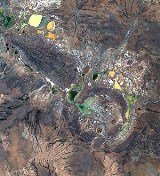
Shoemaker crater
Encyclopedia

Impact structure
The term impact structure is closely related to the terms impact crater or meteorite impact crater, and is used in cases where erosion or burial have destroyed or masked the original topographic feature with which we normally associate the term crater...
(or astrobleme), the deeply eroded remnant of a former impact crater
Impact crater
In the broadest sense, the term impact crater can be applied to any depression, natural or manmade, resulting from the high velocity impact of a projectile with a larger body...
, situated in arid
Arid
A region is said to be arid when it is characterized by a severe lack of available water, to the extent of hindering or even preventing the growth and development of plant and animal life...
central Western Australia
Western Australia
Western Australia is a state of Australia, occupying the entire western third of the Australian continent. It is bounded by the Indian Ocean to the north and west, the Great Australian Bight and Indian Ocean to the south, the Northern Territory to the north-east and South Australia to the south-east...
, about 100 km (62.1 mi) north-northeast of Wiluna
Wiluna, Western Australia
Wiluna is a complex town in the Mid West region of Western Australia. It is situated on the edge of the Western Desert at the gateway to the Canning Stock Route and Gunbarrel Highway. It is the service centre of the local area for the local Aboriginal people, the pastoral industry, mining, and...
. It is named in honour of planetary geologist Eugene Shoemaker.
The prominent ring-like topographic feature, easily seen in satellite images, lies on the boundary between the Palaeoproterozoic Earaheedy Basin and the Archaean Yilgarn Craton
Yilgarn craton
The Yilgarn Craton is a large craton which constitutes the bulk of the Western Australian land mass. It is bounded by a mixture of sedimentary basins and Proterozoic fold and thrust belts...
. The area contains a number of seasonal salt
Salt
In chemistry, salts are ionic compounds that result from the neutralization reaction of an acid and a base. They are composed of cations and anions so that the product is electrically neutral...
lakes, the largest being Lake Teague.
The first suggestion that the ring-like topographic feature may be an impact structure was published in 1974. Subsequent research revealed definitive evidence for this hypothesis, including the presence of shatter cone
Shatter cone
Shatter cones are rare geological features that are only known to form in the bedrock beneath meteorite impact craters or underground nuclear explosions...
s and shocked quartz
Shocked quartz
Shocked quartz is a form of quartz that has a microscopic structure that is different from normal quartz. Under intense pressure , the crystalline structure of quartz will be deformed along planes inside the crystal...
. The feature has a central circular region of uplifted Archaean Granite (Teague Granite) about 12 km (7.5 mi) in diameter, surrounded by a downwarped ring (ring syncline
Syncline
In structural geology, a syncline is a fold, with younger layers closer to the center of the structure. A synclinorium is a large syncline with superimposed smaller folds. Synclines are typically a downward fold, termed a synformal syncline In structural geology, a syncline is a fold, with younger...
) of sedimentary rocks with an outer limit of disturbance at about 30 km (18.6 mi) diameter, which is a minimum estimate of the size of the original crater.
The age of the impact event is uncertain. It must be younger than the Teague Granite in the centre, dated at 2648 ± 8 Ma (million years ago). The most commonly cited age of about 1630 Ma represents a re-heating event affecting the granite; while this may be the impact event it could simply be a regional tectonic event. More recent dating by K–Ar methods yield ages as young as 568 ± 20 Ma, this age could also date the impact event or represent tectonic activity.

